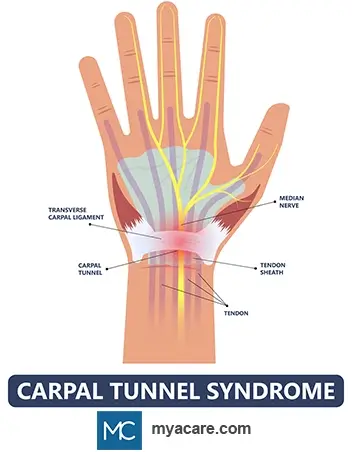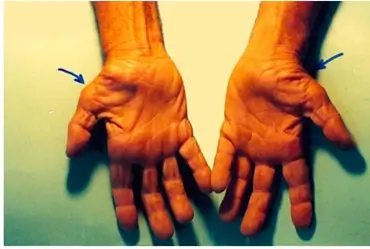Hand Pain and Numbness: Do You Have Carpal Tunnel Syndrome?

Carpal tunnel syndrome (CTS) refers to the constellation of symptoms that arise when your median nerve gets jammed as it passes through your wrist. It is the most common disabling neuropathy and is most frequently seen in people with desk jobs that entail a lot of typing or jobs that require extensive repetitive hand movements (e.g. knitting, scrubbing, typing …etc.).
Symptoms include tingling, numbness, weakness, and pain in the wrists and hands. Early in the disease course, symptoms are occasional, mild, and are mostly felt at night. However, severe compression resulting from delayed diagnosis and treatment tends to increase the intensity and duration of your symptoms.
The treatment options for carpal tunnel syndrome vary depending on your symptoms, the impact of these symptoms on your daily activities and your work, and the severity of your condition. If your symptoms are only minor and intermittent, you may benefit from conservative (i.e., non-surgical) measures, such as wrist splinting for immobilization, evading particular activities, exercises, and local steroid injections. In severe cases, surgical intervention to free your median nerve might be the only option.
What is Carpal Tunnel Syndrome?

Carpal tunnel syndrome (CTS) occurs when your median nerve is compressed within the carpal canal.
The median nerve is a major nerve that extends along your arm, forearm, passes through the carpal tunnel into your wrist, and ends up in your hand. This nerve provides sensation to the palm side of your thumb, index, middle and lateral half of your ring finger. It also controls the movement of your thumb.
The carpal tunnel is a narrow hallway in your wrist, allowing for the passage of several structures, among which is your median nerve.
What are the symptoms of carpal tunnel syndrome?
Early on, carpal tunnel syndrome presents with:
- Burning
- Numbness
- Tingling
- Electric-shock like sensation
These symptoms will mainly affect the fingers supplied by your median nerve (i.e., thumb, index, middle, and part of your ring finger). You might also experience palm pain, sometimes extending all the way up to your arm. Shaking out your hands might relieve these symptoms early on, but not in the advanced stages.
CTS can affect one or both hands, but it usually starts and is more severe in your dominant hand.
Progression of median nerve compression and entrapment ultimately leads to weakness in your hands alongside notable clumsiness (e.g., dropping objects from your hands).
This happens because of reduced grip strength, which results from muscle wasting at the base of your thumb. In such extreme cases, it might become difficult to distinguish between hot and cold sensations, which may lead to accidental burns in your fingertips.

Symptoms are initially present at night and go away during the day. In later stages, the pain and numbness might persist throughout the whole day and become particularly apparent when performing activities that involve wrist movement, such as drawing, typing, and buttoning your shirt.
Carpal tunnel symptoms can flare-up during the day whenever you hold something while bending your wrist, like when you’re driving or reading a newspaper.
What causes carpal tunnel syndrome?
Doctors still don’t know what exactly causes CTS. Generally speaking, the pathophysiology of carpal tunnel syndrome is a combination of both compression and traction forces.
When pressure increases in your carpal canal due to any reason, your median nerve gets trapped and the venous outflow is obstructed. This produces local swelling that disrupts the blood circulation in your hand, resulting in median nerve damage.
The repetitive traction and wrist movements (e.g. extensive typing and knitting) further compress your median nerve and contribute to its injury.
What are the risk factors associated with carpal tunnel syndrome?
There are many factors and/or conditions that increase your risk of developing carpal tunnel syndrome. Some of these risk factors are modifiable and can be adjusted to decrease your chances of developing CTS.
- Genetics: The carpal tunnel is naturally narrower in some individuals. This trait can run in families.
- Gender: Females are three times more likely to develop CTS.
- Fractures and dislocations of wrist bones: This narrows down the carpal tunnel and irritates the median nerve.
- Pregnancy: Hormonal changes lead to fluid retention and collection in the carpal tunnel, exerting pressure on the median nerve.
- Diabetes: One of the complications of diabetes is polyneuropathy, among which is median nerve neuropathy. This increases the susceptibility of this nerve to injury of any sort.
- Thyroid disorders: Hypothyroidism (i.e. underactive thyroid) causes fluid accumulation in the carpal tunnel and contributes to median nerve compression.
- Menopause: Hormonal changes lead to fluid retention and changes in the fat content, such that fluid and fatty tissue accumulation further narrows the carpal tunnel. It is also thought that estrogen, which is decreased in menopausal women, provides protection to nerves prior to menopause.
- Obesity: Increased fatty tissue and accumulation of fluid in the tissue spaces in the carpal tunnel leading to increased pressure.
- Repetitive forceful movements of the wrist lead to significant inflammation in the membranes surrounding the tendons within the carpal tunnel, causing thickening of the tendons and, consequently, increased pressure on the median nerve.
- Rheumatoid arthritis (RA): RA is an autoimmune disease that causes swelling and inflammation at the wrist joint. This leads to increased pressure in the carpal tunnel and compression of the median nerve.
- Occupational factors: Using vibrating tools or working on an assembly line, for example, requires forceful repetitive wrist flexion for extended periods of time. This exerts harmful pressure on the median nerve and may exacerbate an existing nerve dysfunction.
How is carpal tunnel syndrome diagnosed?
Your doctor will start by asking you about your symptoms and your illnesses (e.g. if you have diabetes, hypertension, hypothyroidism, RA …etc.). Then, he/she will examine you. As part of your physical exam, your doctor usually performs two clinical tests:
- Tinel’s sign: Your doctor taps over the palmar aspect of your wrist to check for a tingling sensation in your fingers.
- Phalen test: Your doctor will ask you to press the backs of your hands against each other for a full minute. If you have CTS, you will feel tingling and numbness in your fingers. The faster you feel the tingling, the more severe your condition is.
If the above steps are not enough to diagnose carpal tunnel syndrome, your doctor will ask for some confirmatory studies:
- X-ray of the wrist: Your doctor will order an X-ray if he/she notices restricted wrist motion, or if there are signs of arthritis or trauma.
- Electrodiagnostic tests: These studies determine the function of the median nerve itself, and how well it controls the movement of your muscles.
- Electromyogram: Your doctor will place an electrode into the muscle to measure its electrical activity.
- Nerve conduction studies: Your doctor will tape the electrodes to your skin to measure the speed of the signals in the median nerve.
How is carpal tunnel syndrome treated?
Many treatment options are available for carpal tunnel syndrome depending on the severity of your condition and preference.
If you have mild-to-moderate symptoms, conservative options might be suitable for you. Surgery is your last resort if symptoms are severe and affecting your work and daily activities.
Conservative treatment:
- Lifestyle changes: If your symptoms are due to certain repetitive vigorous movements, then you should try to avoid those movements and take frequent breaks. If your symptoms are worsened by your obesity, you should modify your eating habits and exercise more often.If your condition is worsened by a medical condition you have, your doctor will refer you to a specialist (endocrinologist for your diabetes, rheumatologist for your RA …)
- Exercises: There are many stretching and strengthening exercises that help relieve the pain of CTS. Also, nerve gliding exercises improve the movement of the median within your carpal canal.
- Immobilization: Your doctor may advise you to use a splint to stabilize your wrist and decrease the pressure on your median nerve. He/she may recommend wearing the splint at night to alleviate the numbness and tingling, help you get a good night's sleep, and rest your median nerve.
- Medications: Your doctor may prescribe anti-inflammatory agents to limit the swelling.
- Injections: Local steroid injections are a common non-surgical treatment for CTS. Your doctor might use these injections to provide you with short-term relief while you prepare for your surgery. This option does not replace your need for surgery if your carpal tunnel syndrome is severe.
Surgical treatment:
If all the above treatment modalities fail, you might need to get a “carpal tunnel release” which is a procedure that expands the size of the carpal tunnel and releases the pressure applied on your median nerve.
What are the potential risks of carpal tunnel release surgery?
With every surgery, there come several risks. The risks of carpal tunnel release surgery include:
- Bleeding
- Damage to your median nerve or nearby structures
- Infection
- Scarring
The medical team will put you under brief observation for any possible complications.
What to expect after your carpal tunnel release surgery?
- You will be safely discharged home on the same day of your operation.
- You should notice immediate relief from the burdensome symptoms of carpal tunnel syndrome.
- You should expect pain, swelling, and some stiffness after your surgery. This might last from several weeks up to several months. Your doctor will prescribe agents to control these symptoms.
- You will have to wear a splint or wrist brace for a few weeks after your surgery, in addition to limiting your activity to only light movements.
- Grip strength typically returns 2-3 months after your surgery. If your median nerve was badly damaged prior to surgery, strength may need up to one year to be restored.
- Your doctor will discuss with you the optimal timing to get back to work and will advise you on what activities to restrict.
FAQs about carpal tunnel syndrome
1. What happens if you don’t treat carpal tunnel?
The symptoms of carpal tunnel syndrome are gradual. In the early stages, they are mild and only present at night. However, as the condition progresses, symptoms become constant and severe. If left untreated, irreversible damage to the median nerve might occur, leading to impaired sensation in your fingers as well as wasting of the muscles at the base of your thumb. If you reach this stage, even surgery cannot completely correct your sensation and strength.
2. How to stop the numbness in my hands when I sleep?
To prevent numbness in your hands when you sleep, you are advised to rest your hand and wrist during the day and to wear a brace to diminish wrist movement. The use of a wrist brace is particularly important at night, as it prevents wrist flexion during sleep.
3. Can carpal tunnel syndrome recur?
This is very unlikely. The success rate for carpal tunnel release surgery is very high, reaching up to 90%. If carpal tunnel syndrome recurs, you will need further treatment or revision surgery.
4. Can you prevent carpal tunnel syndrome?
There are a quite few tips to prevent carpal tunnel syndrome:
- Proper posturing
- Ergonomic workplaces
- Frequent stretching of the hands and wrists
- Regular breaks to move your arms and hands
- Changing positions during your workday
To search for the best Orthopedics Healthcare Providers in Croatia, Germany, India, Malaysia, Singapore, Spain, Thailand, Turkey, Ukraine, the UAE, UK and the USA, please use the Mya Care search engine.
Dr. Mersad is a medical doctor, author, and editor based in Germany. He has managed to publish several research papers early in his career. He is passionate about spreading medical knowledge. Thus, he spends a big portion of his time writing educational articles for everyone to learn.
Sources:
Featured Blogs



